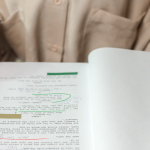
28 Jun How to implement comparative judgement in the classroom
Comparative judgement is a proven alternative method for assessing complex competences such as writing assignments, presentations, portfolios or visual works. But how do you implement comparative judgement in the classroom? Find out in this article!
Research shows that comparative judgement leads to higher reliability than traditional assessment methods. During comparative judgement, for instance, an assessor consistently makes more consistent decisions. And this regardless of the time of day, mood and order of work.
But also differences between assessors are mitigated by the method. You may differ greatly in severity from a colleague, for example. In an analytical and absolute assessment it is then unlikely that you would give the same score to the same piece of work. With comparative judgement, however, there is a good chance that several assessors will point out the same piece of work as the better one in a comparison.
Convinced? Great! But how do you apply comparative judgement in the classroom? These tips will help you on your way!
In theory
With comparative judgement, the assessor compares the pieces of work, ideally, in randomly generated pairs. With each comparison, he indicates the better work of the two. Finally, based on all these comparisons, a rank order emerges, with the products ranked from lower to higher quality. If desired, this ranking can be linked to scores.
In practice
If you have a manageable number of products, about 15 to 20, you can compile the quality scale yourself. There is no need to work pairwise. You simply compare each task with a randomly chosen other task. Then you rank them from lower to higher quality. You only assign scores at the end when the ranking is complete.
Make use of benchmarks
If you have benchmarks available, you can use them as reference points. Such benchmarks are usually tasks from previous years that have already received a value judgement or mark. Compare the new tasks with the benchmarks. Then, you determine the ranking of the new task by giving it a place among the benchmarks.
Work with a comparing tool
When you have more than 20 tasks to assess, it becomes difficult to do the comparative judgement manually. In this case, a tool that supports comparative judgement can help. After the students have uploaded their work, the tool will compile random pairs that the assessors can compare. For a new pair, the algorithm always selects the product that has been compared the least. This ensures that each product is compared an equal number of times. In the end, the tool brings all this input together. The result: a quality scale that ranks the products and reflects the consensus between assessors.
Do you want to start comparing? Read more about our comparing tool or contact us with your specific questions!




